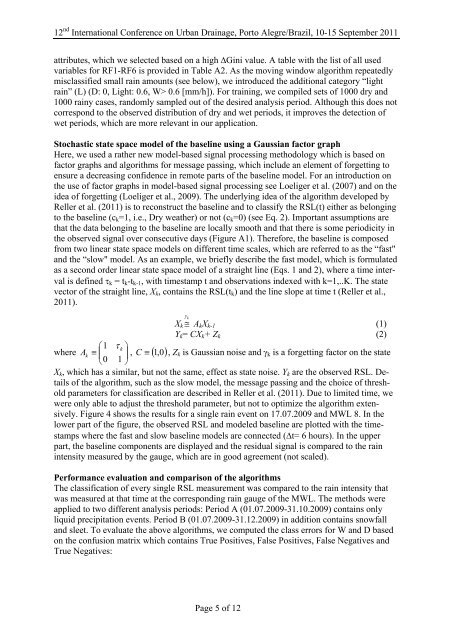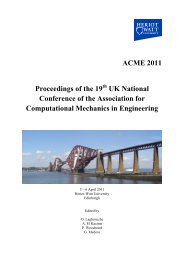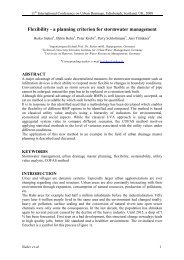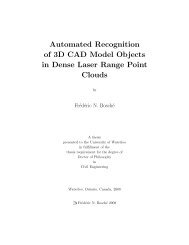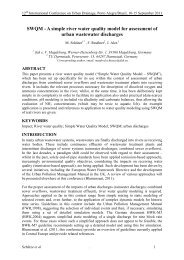Identification of dry and rainy periods using telecommunication ...
Identification of dry and rainy periods using telecommunication ...
Identification of dry and rainy periods using telecommunication ...
You also want an ePaper? Increase the reach of your titles
YUMPU automatically turns print PDFs into web optimized ePapers that Google loves.
12 nd International Conference on Urban Drainage, Porto Alegre/Brazil, 10-15 September 2011<br />
attributes, which we selected based on a high �Gini value. A table with the list <strong>of</strong> all used<br />
variables for RF1-RF6 is provided in Table A2. As the moving window algorithm repeatedly<br />
misclassified small rain amounts (see below), we introduced the additional category “light<br />
rain” (L) (D: 0, Light: 0.6, W> 0.6 [mm/h]). For training, we compiled sets <strong>of</strong> 1000 <strong>dry</strong> <strong>and</strong><br />
1000 <strong>rainy</strong> cases, r<strong>and</strong>omly sampled out <strong>of</strong> the desired analysis period. Although this does not<br />
correspond to the observed distribution <strong>of</strong> <strong>dry</strong> <strong>and</strong> wet <strong>periods</strong>, it improves the detection <strong>of</strong><br />
wet <strong>periods</strong>, which are more relevant in our application.<br />
Stochastic state space model <strong>of</strong> the baseline <strong>using</strong> a Gaussian factor graph<br />
Here, we used a rather new model-based signal processing methodology which is based on<br />
factor graphs <strong>and</strong> algorithms for message passing, which include an element <strong>of</strong> forgetting to<br />
ensure a decreasing confidence in remote parts <strong>of</strong> the baseline model. For an introduction on<br />
the use <strong>of</strong> factor graphs in model-based signal processing see Loeliger et al. (2007) <strong>and</strong> on the<br />
idea <strong>of</strong> forgetting (Loeliger et al., 2009). The underlying idea <strong>of</strong> the algorithm developed by<br />
Reller et al. (2011) is to reconstruct the baseline <strong>and</strong> to classify the RSL(t) either as belonging<br />
to the baseline (ck=1, i.e., Dry weather) or not (ck=0) (see Eq. 2). Important assumptions are<br />
that the data belonging to the baseline are locally smooth <strong>and</strong> that there is some periodicity in<br />
the observed signal over consecutive days (Figure A1). Therefore, the baseline is composed<br />
from two linear state space models on different time scales, which are referred to as the “fast"<br />
<strong>and</strong> the “slow" model. As an example, we briefly describe the fast model, which is formulated<br />
as a second order linear state space model <strong>of</strong> a straight line (Eqs. 1 <strong>and</strong> 2), where a time interval<br />
is defined �k = tk-tk-1, with timestamp t <strong>and</strong> observations indexed with k=1,..K. The state<br />
vector <strong>of</strong> the straight line, Xk, contains the RSL(tk) <strong>and</strong> the line slope at time t (Reller et al.,<br />
2011).<br />
� k<br />
Xk � AkXk-1<br />
(1)<br />
Yk= CXk+ Zk<br />
(2)<br />
where �� �1<br />
� k �<br />
Ak<br />
� �� , C � �1, 0�,<br />
Zk is Gaussian noise <strong>and</strong> �k is a forgetting factor on the state<br />
�0<br />
1 �<br />
Xk, which has a similar, but not the same, effect as state noise. Yk are the observed RSL. Details<br />
<strong>of</strong> the algorithm, such as the slow model, the message passing <strong>and</strong> the choice <strong>of</strong> threshold<br />
parameters for classification are described in Reller et al. (2011). Due to limited time, we<br />
were only able to adjust the threshold parameter, but not to optimize the algorithm extensively.<br />
Figure 4 shows the results for a single rain event on 17.07.2009 <strong>and</strong> MWL 8. In the<br />
lower part <strong>of</strong> the figure, the observed RSL <strong>and</strong> modeled baseline are plotted with the timestamps<br />
where the fast <strong>and</strong> slow baseline models are connected (�t= 6 hours). In the upper<br />
part, the baseline components are displayed <strong>and</strong> the residual signal is compared to the rain<br />
intensity measured by the gauge, which are in good agreement (not scaled).<br />
Performance evaluation <strong>and</strong> comparison <strong>of</strong> the algorithms<br />
The classification <strong>of</strong> every single RSL measurement was compared to the rain intensity that<br />
was measured at that time at the corresponding rain gauge <strong>of</strong> the MWL. The methods were<br />
applied to two different analysis <strong>periods</strong>: Period A (01.07.2009-31.10.2009) contains only<br />
liquid precipitation events. Period B (01.07.2009-31.12.2009) in addition contains snowfall<br />
<strong>and</strong> sleet. To evaluate the above algorithms, we computed the class errors for W <strong>and</strong> D based<br />
on the confusion matrix which contains True Positives, False Positives, False Negatives <strong>and</strong><br />
True Negatives:<br />
Page 5 <strong>of</strong> 12


